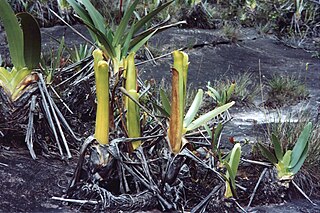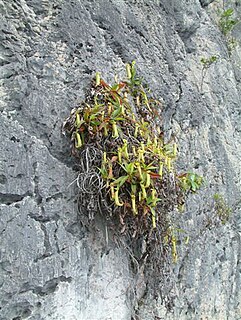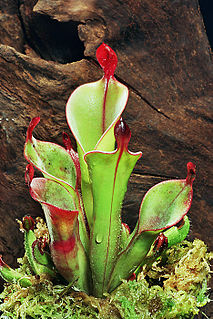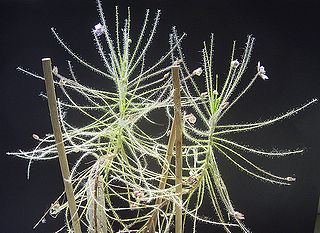Related Research Articles

Pitcher plants are several different carnivorous plants which have modified leaves known as pitfall traps—a prey-trapping mechanism featuring a deep cavity filled with digestive liquid. The traps of what are considered to be "true" pitcher plants are formed by specialized leaves. The plants attract and drown their prey with nectar.

Drosera, commonly known as the sundews, is one of the largest genera of carnivorous plants, with at least 194 species. These members of the family Droseraceae lure, capture, and digest insects using stalked mucilaginous glands covering their leaf surfaces. The insects are used to supplement the poor mineral nutrition of the soil in which the plants grow. Various species, which vary greatly in size and form, are native to every continent except Antarctica.

Brocchinia reducta is one of few carnivorous bromeliads. It is native to southern Venezuela, Brazil, Colombia, and Guyana, and is found in nutrient-poor soil. B. reducta adapts to different environments, when growing on rocks it uses its roots as anchors.

Droseraceae is a family of carnivorous flowering plants, also known as the sundew family. It consists of approximately 180 species in three extant genera. Representatives of the Droseraceae are found on all continents except Antarctica.

The Venus flytrap is a carnivorous plant native to subtropical wetlands on the East Coast of the United States in North Carolina and South Carolina. It catches its prey—chiefly insects and arachnids—with a trapping structure formed by the terminal portion of each of the plant's leaves, which is triggered by tiny hairs on their inner surfaces.

Lithophytes are plants that grow in or on rocks. Those that grow on rocks are also known as epipetric or epilithic plants.

Lentibulariaceae, the bladderwort family, is a family of carnivorous plants containing three genera: Genlisea, the corkscrew plants; Pinguicula, the butterworts; and Utricularia, the bladderworts.

Genlisea is a genus of carnivorous plants also known as corkscrew plants. The 30 or so species grow in wet terrestrial to semi-aquatic environments distributed throughout Africa and Central and South America. The plants use highly modified underground leaves to attract, trap and digest minute microfauna, particularly protozoans. Although suggested a century earlier by Charles Darwin, carnivory in the genus was not proven until 1998.

The genus Heliamphora contains 23 species of pitcher plants endemic to South America. The species are collectively known as sun pitchers, based on the mistaken notion that the heli of Heliamphora is from the Greek helios, meaning "sun". In fact, the name derives from helos, meaning marsh, so a more accurate translation of their scientific name would be marsh pitcher plants. Species in the genus Heliamphora are carnivorous plants that consist of a modified leaf form that is fused into a tubular shape. They have evolved mechanisms to attract, trap, and kill insects; and control the amount of water in the pitcher. At least one species produces its own proteolytic enzymes that allows it to digest its prey without the help of symbiotic bacteria.

Byblis is a small genus of carnivorous plants, sometimes termed the rainbow plants for the attractive appearance of their mucilage-covered leaves in bright sunshine. Native to western Australia, it is the only genus in the family Byblidaceae. The first species in the genus was described by the English botanist Richard Anthony Salisbury in 1808. Eight species are now recognized.

Brocchinia is a genus of the botanical family Bromeliaceae, and is the sole genus of the subfamily Brocchinioideae, containing 20 species. The genus is named for Giovanni Battista Brocchi, Italian naturalist (1772–1826). Brocchinia species are native primarily to the ancient Guayana Shield in southern Venezuela and Guyana, with some species extending into Colombia and northern Brazil. Its species are generally restricted to areas of sand and sandstone of the Roraima Formation; a few occur on granite.

Catopsis berteroniana, commonly known as the powdery strap airplant, is an epiphytic bromeliad thought to be a possible carnivorous plant, similar to Brocchinia reducta, although the evidence is equivocal. Its native range is from southern Florida to southern Brazil. It generally grows on the unshaded twigs of trees, and has been shown experimentally to trap more insects in its tank than other bromeliads of comparable size. There are several other species in the genus, none of which is believed to be carnivorous.

Paepalanthus bromelioides is a species in the flowering plant family Eriocaulaceae. This family is placed in the Poales, close to the Bromeliaceae, whose morphology this genus shares. Paepalanthus bromelioides is native to Cerrado, the area in which the carnivorous bromeliad Brocchinia reducta is also found. There is some speculation that the occasional insects trapped in the urn of this plant are evidence of its being a carnivorous plant.

A protocarnivorous plant, according to some definitions, traps and kills insects or other animals but lacks the ability to either directly digest or absorb nutrients from its prey like a carnivorous plant. The morphological adaptations such as sticky trichomes or pitfall traps of protocarnivorous plants parallel the trap structures of confirmed carnivorous plants.
Genlisea margaretae is a carnivorous species in the genus Genlisea native to areas of Madagascar, Tanzania, and Zambia. It has pale bundles of root-like organs up to about 20 cm long under ground that attract, trap, and digest protozoans. These organs are subterranean leaves, which lack chlorophyll. It had been known to possess the smallest known genome of any flowering plant as of 2006, but was later surpassed by the related species Genlisea tuberosa.
Colura is a genus of epiphytic liverworts and consists of approximately 60 species that are distributed mostly in the tropics. Species in this genus are no larger than a couple millimetres in size and may possess small water sac organs formed from fused leaf margins that trap small ciliates. It is because of this trapping mechanism that some species have been suspected of carnivory, even as early as 1893. One such species, Colura zoophaga, was the subject of a study that aimed to investigate the assumed carnivorous habit among liverworts. The results confirmed that ciliates were captured and died within the water sac traps, which are not unlike the bladder traps of Utricularia. Whether the species attract, digest, or absorb the prey has not been confirmed, however. The epiphytic habit of the genus, requiring all nutrients to be acquired from rainwater, is similar to the habit of known carnivorous plants.

Utricularia humboldtii is a large perennial carnivorous plant that belongs to the genus Utricularia. Peter Taylor lists it as either an "aquatic-epiphyte", a subaquatic or a terrestrial species. U. humboldtii is endemic to South America, where it is found in Brazil, Guyana, and Venezuela. It was originally published and described by Robert Hermann Schomburgk in 1840. It is usually found growing in the water-filled leaf axils of some species of bromeliad, including Brocchinia micrantha, B. tatei, and B. reducta and also plants in the genus Orectanthe. It also grows as an epiphyte on tree trunks or as a subaquatic or terrestrial species in shallow water or wet soil in open savanna. It is found mostly between altitudes of 1,200 m (3,937 ft) and 2,500 m (8,202 ft), though it has been found at altitudes as low as 300 m (984 ft). It has been collected in flower throughout every month of the year.

Carnivorous plants are plants that derive some or most of their nutrients from trapping and consuming animals or protozoans, typically insects and other arthropods. Carnivorous plants have adapted to grow in places where the soil is thin or poor in nutrients, especially nitrogen, such as acidic bogs. Charles Darwin wrote Insectivorous Plants, the first well-known treatise on carnivorous plants, in 1875. Carnivorous plants can be found on all continents except Antarctica, as well as many Pacific islands.

Pleurozia is the only genus of liverworts in the family Pleuroziaceae, which is now classified in its own order Pleuroziales, but was previously included in a broader circumscription of the Jungermanniales. The genus includes twelve species, and as a whole is both physically distinctive and widely distributed.

Pinguicula, commonly known as the butterworts, is a genus of carnivorous flowering plants in the family Lentibulariaceae. They use sticky, glandular leaves to lure, trap, and digest insects in order to supplement the poor mineral nutrition they obtain from the environment. Of the roughly 80 currently known species, 13 are native to Europe, 9 to North America, and some to northern Asia. The largest number of species is in South and Central America.
References
- 1 2 3 4 5 Barthlott, W., Porembski, S., Seine, R., and Theisen, I. (2007). The Curious World of Carnivorous Plants: A Comprehensive Guide to Their Biology and Cultivation. Portland, Oregon: Timber Press. pp. 180-181.
- 1 2 3 4 Barthlott, W., Fischer, E., Frahm, J.-P., and Seine, R. (2000). First experimental evidence for zoophagy in the hepatic Colura. Plant Biology (Stuttgart), 2: 93-97.
- ↑ Goebel, K. (1893). Zur Biologie von Genlisea. Flora, 77: 208-212.
- ↑ Marilaun, A.K. von. (1922). Pflanzenleben. 3rd ed. Vol. 1. Leipzig, Vienna.
- ↑ Juniper, B.E., Robbins, R.J., and Joel, D.M. (1989). The Carnivorous Plants . London: Academic Press. ISBN 0-12-392170-8
- ↑ Givnish, T.J., Burkhardt, E.L., Happel, R.E., and Weintraub, J.D. (1984). Carnivory in the bromeliad Brocchinia reducta, with a cost/benefit model for the general restriction of carnivorous plants to sunny, moist, nutrient-poor habitats. American Naturalist, 124: 479-497.